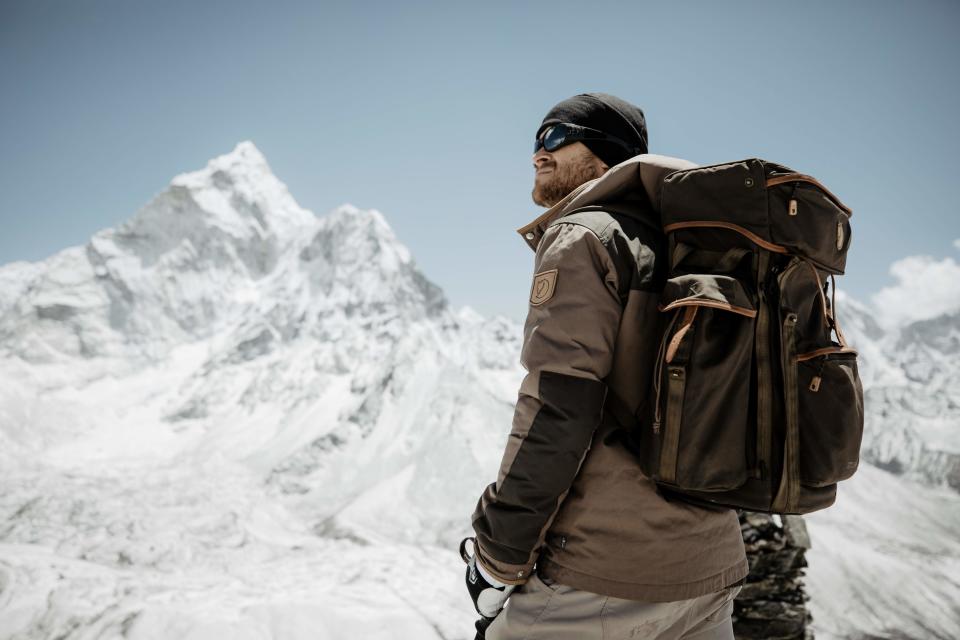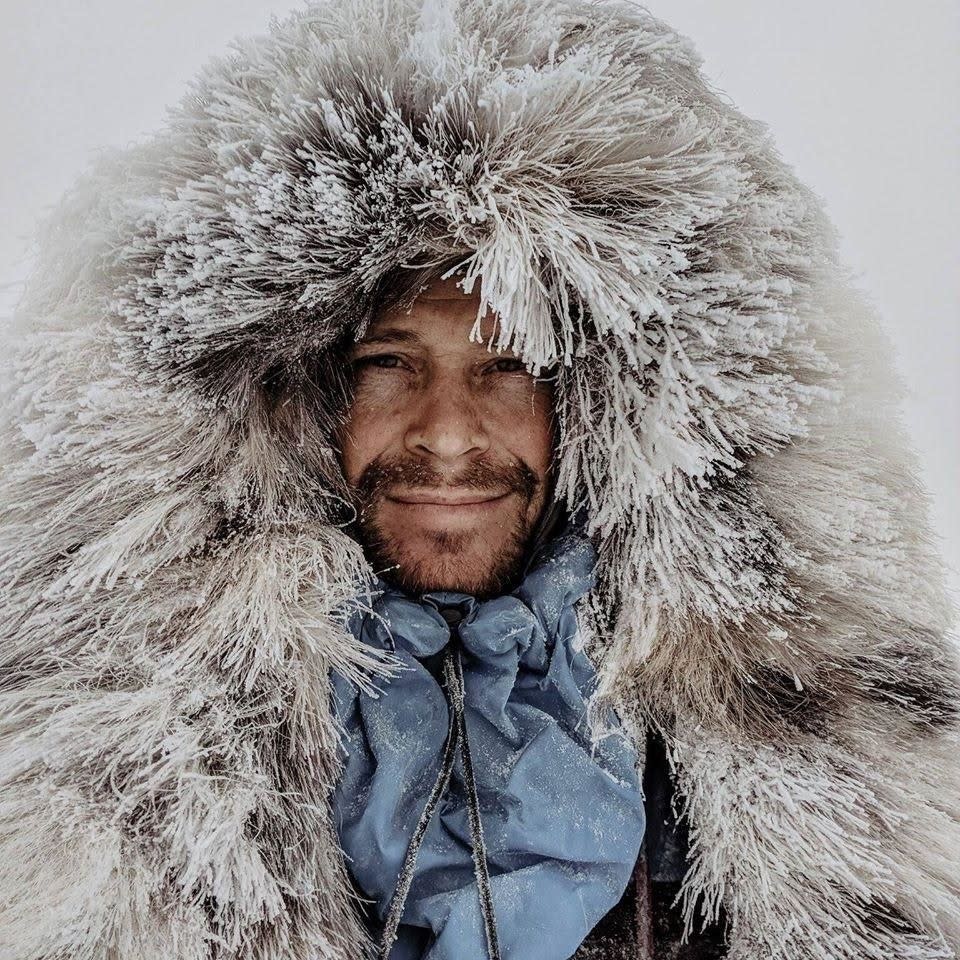The Real-Life Diet of an Iditarod Musher, Who Eats When His Dogs Eat
Two weeks after moving to Alaska in August 2014, Larry Daugherty, now 44, met well-known Iditarod musher Jim Lanier at a book signing.
Like Daugherty, Lanier trained at the Mayo Clinic and worked in medicine. They hit it off immediately. Daugherty considered it fate—he’d always dreamed of coming to Alaska and of dog sledding there. Lanier told him to stop by his kennel sometime. Daugherty went the next day, and kept showing up afterwards.
Almost six years later, on Saturday, March 7, Daugherty will compete in the Iditarod Trail Sled Dog Race for the fourth time. The event features the best mushers in the world in tandem with their teams of 14 dogs, and over the course of nine to 12 days, competitors traverse through nearly 1,000 miles of treacherous terrain from Anchorage to Nome (roughly the same distance as Los Angeles to Portland). To date, Daugherty’s best finish is 10 days, 18 hours, 29 minutes, and 10 seconds. This time around, Daugherty is running a “B team” from a larger kennel so those dogs can get some racing experience. They’re on the younger side, but the hope is by next year, they’ll be on the varsity squad for an Iditarod champion.
The Iditarod is just Daugherty’s warm-up. Three weeks after the race, he’s planning on climbing Mount Everest. He’s no newbie climber, having summited peaks all over the world, including Denali, Elbrus, Aconcagua, Kilimanjaro, Alpamayo, and Lobuche. But this marks the second time he’s tried for what he’s dubbed the “Iditarest,” which means what you think it means. His first attempt in 2017 didn’t go according to plan during its latter half—he was turned around by dangerous weather an hour from the summit.

In an interview with GQ, Daugherty explains what drives him to put his body through two physically demanding events back-to-back, and how he trains for wildly different athletic feats.
GQ: You’ll have less than a month between the Iditarod and Everest. What’s your strategy to prepare for both of them?
Larry Daugherty: Part of what makes the Iditarest such a challenge is that the Iditarod is pretty much the last thing a climber would want to put their body through right before an 8,000-meter climb. My primary focus in training has been to get myself in the best shape of my life. The toll on my body is severe with a 1,000-mile dog sled race. But I won’t run as punishing of a race as the elite mushers. Both in the interest of the dogs, as well as myself, I plan to run a conservative race—my goal is to finish. There is certainly a risk in the Iditarod of injury or other detriments to my body that would impact my Everest climb.
What is your fitness routine right now?
A typical training routine for me is two hours of cardio per day and one additional hour of strength training or core. I spend a lot of time at the Alaska Rock Gym. They have everything I need, from a StairMaster to a treadmill to weights. Then I reward myself after my workouts with some climbing—it’s my treat for finishing my workout. Running on the treadmill facing the climbs is a motivator for me. I also do regular hikes in the mountains near my house.
What do you do for weight training?
Primarily legs and core. Tons of squats and crunches, which I do every day. I also do upper body a few times a week. I try to constantly do micro workouts. At work, every time I see a patient, I’ll go into my office afterwards and do some curls before seeing the next patient. I also installed a pull-up bar in the clinic, so every time I walk by I do some pull-ups.
One thing I know about expeditions is that the food isn’t exactly gourmet. What do you pack to eat to fuel yourself?
On the mountain there's a lot of meat and rice, some of which we get at tea houses on the way to base camp, and some of which our expedition cook makes. I bring plenty of snacks from home. Primarily things that give you energy. I’m a big fan of peanut butter and Snickers bars. When the altitude starts to hit me, I find I can’t choke down a Clif Bar or protein bar, so it’s usually softer stuff that I’m taking in.
I assume that differs from your diet at home. You’re probably not eating Snickers every day?
Yeah, that’s for sure. I’ve been in training for the last year, so I’ve really tried to clean up my diet a lot. I eat very little sugar. Mostly vegetables, lean meats, and protein shakes.
When you’re mushing, you’re responsible for feeding both yourself and the 14 dogs. How do you juggle that? I’ve heard the dogs need roughly 10,000 calories a day when they’re racing.
On the Iditarod trail, I eat when the dogs eat. The dogs primarily eat beef and fish. That’s also how the dogs get a lot of their water content, because the protein is frozen, and we essentially make a goulash for them by heating snow until it’s melted and boiling. I cook their food in that. They usually eat four times a day. At that point, it’s easiest for me to heat vacuum-sealed meals for myself. Things like shepherd's pie, pasta, and soup. I’m focused more on the dogs' nutrition on the trail.
What’s the biggest challenge associated with running in the Iditarod?
Sleep deprivation. That’s really the hardest part. I usually stop for six hours at a checkpoint, which is considered a large amount of rest; the elite mushers will take between two and four hours at a checkpoint. At least two hours of that time is spent taking care of the dogs and melting snow to get water. Taking care of each and every paw. Rubbing sore muscles. Just really obsessing over the health of the dogs so they can get you through this thousand mile adventure. You just don't get a lot of sleep. You also can't plan on storms that are going to hit and how that might affect your race plan.

How do you come down from events of this magnitude? A Netflix binge? A half-marathon?
I’ll sleep for 12 hours a day for two or three days after the Iditarod. I feel like I can’t get enough sleep and can’t get enough food. I usually lose five to 10 pounds on the trail. And being a father of five who’s gone for this event, “coming down” usually means reconnecting and spending meaningful time with my family.
What’s next after the Iditarest?
I’m taking my daughter and her friends up Mount Rainier this summer. Then in June 2021, my son wants to climb Denali for his senior trip, and we’re training to do that together. I’ve already climbed it once before. After that, I have a few more of the Seven Summits to do. From an adventure standpoint, those are my big goals right now.
This interview has been edited and condensed for clarity.
Real-Life Diet is a series in which GQ talks to athletes, celebrities, and everyone in-between about their diets and exercise routines: what's worked, what hasn't, and where they're still improving. Keep in mind, what works for them might not necessarily be healthy for you.
John Karangis wakes up at the crack of dawn to train, then heads into the office to invent new Shake Shack menu items.
Originally Appeared on GQ


